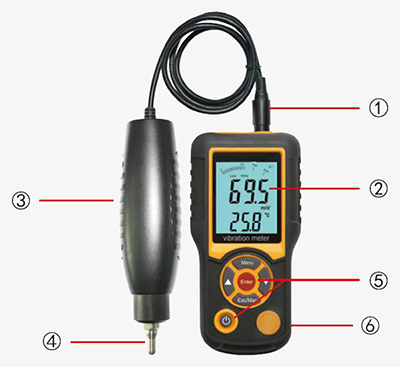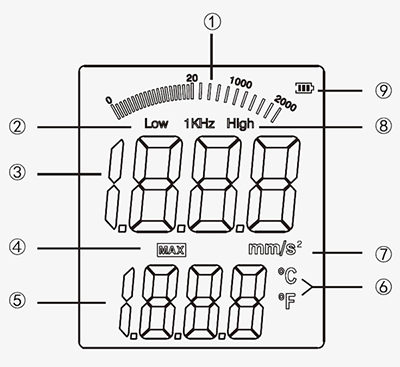The digital vibration check meter can measure vibration speed, acceleration and displacement. It has an acceleration measurement range of 0.1~199.9m/s2 peak. The vibration tester uses a piezoelectric accelerometer to convert the vibration signal into an electrical signal and analyze the input signal.
Features
- LCD display the measurement result and condition directly.
- Acceleration, velocity and displacement can be measured.
- Acceleration, velocity and displacement measurement.
- Optional vibration frequency.
- Use high sensitivity probe for precise measurement.
- Two probes (short and long) offered, to meet different requirement of measurement.
- Attached a magnetic sucker, in case of the measurement inconvenient by handheld.
- Low battery indication, auto shutdown, and LCD backlight.
- Max. value hold function.
- Selectable temperature unit ℃/℉.

Handheld digital vibration tester details
- ① Host interface
- ② LCD display
- ③ Handle
- ④ Probe
- ⑤ Key
- ⑥ Battery box (at the back of the vibration meter)
- ▲: Switching the temperature unit
- ▼: Switching speed, acceleration and displacement unit
- Esc/Max: Exit/maximum value hold
- Menu: Enter password input interface (only used for debugging before delivery)

LCD display details
- ① Frequency analog bar
- ② LOW: low-frequency indication(<1KHz)
- ③ Measurement reading
- ④ MAX: Maximum value
- ⑤ Temperature readings
- ⑥ Temperature unit (C: Degree centigrade, F: Fahrenheit degree)
- ⑦ Acceleration unit: m/s2, Speed unit: mm/s, Displacement unit: mm
- ⑧ High: High-frequency indication (>1KHz)
- ⑨ Battery level indication
Applications
sisco handheld digital vibration meter is suitable for routine testing the vibration of machinery and equipment, especially the vibration of rotating and reciprocating machinery. It can measure acceleration, velocity and displacement, which is widely used in mechanical manufacturing, electric metallurgy, general aviation etc.

| Model | SISCO-HT1201 |
| Vibration acquisition | Piezoceramic accelerometer (shearing type) |
| LCD display | Three and a half digit display |
| Acceleration | 0.1-199.9m/s2( peak value) |
| Speed | 0.1-199.9mm/s(effective value) |
| Displacement | 0.001-1.999mm (effective value) |
| Measurement accuracy | +(5%+2digits) |
| Acceleration | 15Hz-1KHz (LO), 1KHz-10KHz (HI) |
| Speed | 15Hz-1KHz (LO) |
| Displacement | 15Hz-1KHz (LO) |
| Temperature measurement | 0℃-60℃ |
| Temperature accuracy | +2C |
| Automatic power-off time | 4 minutes |
| Power supply | 3*AA batteries |
| Operation temperature | 0℃-45℃ |
| Storage temperature | -20℃-60℃ |
| Weight of the host | 140g |
| Dimension of the host | 152mmx75mmx32mm |
Q1: What is a vibration meter?
A1: Vibration meter is used to directly indicate the peak, peak-to-peak, mean value or root mean square value of vibration quantity such as displacement, velocity, acceleration and derivative of acceleration. The main parts of this vibration tester are integral differential circuit, amplifier circuit, voltage detector and meter head. The integral and differential circuit is used to complete the integral and differential operation between the above vibration quantities. Generally, the integral and differential operational amplifier can be used, and the low-pass filter and high-pass filter can be used respectively to complete the integral and differential operation. However, attention should be paid to their application frequency range when using such instruments for calculation. The vibration meter allows one to obtain only the total intensity of the vibration (the vibration level) and no other information.
Q2: How does a vibration meter work?
A2: Mechanical vibration is generally measured by electrical measurement. The basic principle of vibration meter is to convert mechanical quantity into electric quantity through vibration sensor, and then measure and analyze the electric quantity, so as to obtain various parameter values of the measured mechanical vibration quantity. In the field vibration test of turbine generator set, the vibration sensor commonly used in vibration tester has three types, they are eddy current non-contact displacement sensor to measure the relative vibration of rotating shaft, inertia speed sensor and voltage acceleration sensor to measure the vibration of bearing seat and foundation, cylinder structure and so on. In addition, in order to measure the absolute vibration of a rotating shaft, a composite sensor consisting of an eddy current non-contact displacement sensor and an inertial velocity sensor is often used.
Q3: What does a vibration meter do?
A3: The vibration meter can easily measure the vibration parameters such as vibration, acceleration and velocity. The vibration tester can also be used to reliably and quantitatively evaluate the vibrations of rotating and reciprocating machines. It is widely used in mechanical design and manufacture, military, electric power, equipment management, transportation and environmental protection departments etc. The vibration meter provides these fields great convenience for on-line inspection and monitoring of machine equipment faults and aging signals, product quality control, vibration test measurement and vibration control.
Tips for using portable vibration meter
- Don't dismantle the casing of the vibration meter.
- Don't use the handheld vibration meter in an environment with explosive gas, steam and damp environment.
- When the measurement is carried out near the rotating part of the machine, operate carefully to avoid being pulled into the machine.
- Please use a dry cloth to wipe the instrument case at the time of cleaning. Don't use corrosive detergents.
- Please take out the battery if the portable vibration meter is not in use for a long time or the storage temperature is higher than 50℃ to avoid corrosion to the vibration tester due to battery leakage.
Thank you for buying industrial test and measurement equipment on SISCO.com, all products sold by SISCO and the partner cover a 12 months warranty, effective from the date of receiving the products.
What is covered?
SISCO is responsible for providing free spare parts, and free technical support to assist the customer to repair the defective products until the problem is solved.
What is not covered?
- Product purchased from anyone other than a SISCO store or a SISCO authorized reseller.
- Expendable parts.
- Routine cleaning or normal cosmetic and mechanical wear.
- Damage from misuse, abuse or neglect.
- Damage from use of parts other than SISCO approved.
- Damage from use outside the product’s usage or storage parameters.
- Damage from use of parts not sold by SISCO.
- Damage from modification or incorporation into other products.
- Damage from repair or replacement of warranted parts by a service provider other than a SISCO authorized service provider.
- Damage caused by the application environment not meeting the product usage requirements and the failure to perform preventive maintenance.

